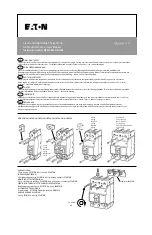
10
Interrupter/Operator Description
Figure 12:
Upper and Lower Primary Disconnects.
Figure 13a:
Barrier Arrangement with Molded Pole Design.
Phase C pole shows in “ghosted” view to
show inner detail of pole
Figure 13b:
Barrier Arrangement with Individual Barriers.
Primary Disconnects
Figure 12
is a side view of the circuit breaker with side
phase barriers removed to show details of the primary
disconnects. Each circuit breaker has three upper and three
lower primary disconnects. Upper primary disconnects are
connected to the stationary contacts of the vacuum inter-
rupters, and the lower primary disconnects to the movable
contacts. Each disconnect arm has a set of multiple spring
loaded fingers that mate with bus bars in the metal-clad
switchgear. The number of fingers in the disconnect
assembly varies with the continuous and/or momentary
rating of the circuit breaker.
There are three insulating push rods. Each push rod
connects the movable contact of one of the vacuum inter-
rupters to the jack shaft driven by the closing and tripping
mechanism. Flexible connectors ensure secure electrical
connections between the movable contacts of each inter-
rupter and its bottom primary disconnect.
Phase Barriers
Phase barrier configurations vary among GMI circuit
breakers depending on voltage and continuous current
ratings.
Figure 13a and 13b
are a rear views of a circuit breaker that
shows the two types of phase barrier configurations; molded
“chair” around individual pole and individual barriers configu-
rations. The insulated “chair” molded barrier is fixed
mounting. Individual barrier configuration includes two outer
(phase to ground) insulating barriers and two interphase
barriers. The interphase barriers are not provided on all circuit
breaker ratings. The sheets of glass polyester insulating
material and the insulated molded chair are attached to the
circuit breaker and provide electrical insulation between the
vacuum interrupter primary circuits and the housing.
Stored Energy Operating Mechanism
The stored energy operating mechanism of the GMI circuit
breaker is an integrated arrangement of springs, solenoids
and mechanical devices designed to provide a number of
critical functions. The energy necessary to close and open
the contacts of the vacuum interrupters is stored in
powerful tripping and closing springs. The closing springs
are normally charged automatically, but there are provisions
for manual charging. The operating mechanism that
controls charging, closing and tripping functions is fully trip-
free, i.e., spring charging does not automatically change the
position of the primary contacts, and the closing function
may be overridden by the tripping function at any time.
Note:
Two different latch systems have been used in GMI circuit
breakers, with changeover from one design to the other occurring
in mid-1991. This instruction manual describes both designs.
Pages 11-13 describe the operation of the mechanism used begin-
ning in approximately mid-1991.
Pages 13-15 describe the operation of the mechanism used from
1989 until approximately mid-1991.
Phase C outer barrier removed to show
pole detail. Interphase barriers are not
used on all ratings.













































